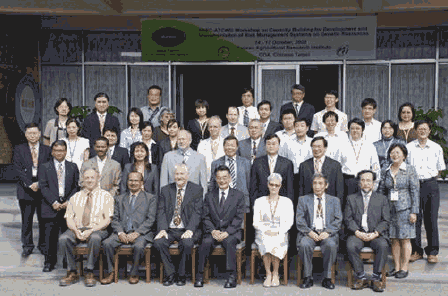Tainan, Taiwan
October 24, 2008
Source:
The
World Vegetable Center Newsletter
 The
biological and agricultural diversity of our planet is crucial
to sustaining human livelihoods. In fact, the improvement of
food and agricultural production depends upon abundant genetic
resources and the application of knowledge through research.
However, every hour, three animal and plant species become
extinct — an irreversible process. The
biological and agricultural diversity of our planet is crucial
to sustaining human livelihoods. In fact, the improvement of
food and agricultural production depends upon abundant genetic
resources and the application of knowledge through research.
However, every hour, three animal and plant species become
extinct — an irreversible process.
Safeguarding genetic diversity in genebanks is vital, but there
is always a high risk of loss, injury, erosion, or extinction of
germplasm conserved in seed genebanks or in field genebanks due
to numerous
factors.
An international workshop organized by the APEC Agricultural
Technical Cooperation Working Group (ATCWG) and held from 13 –
17 October 2008 at the Taiwan Agricultural Research Institute in
Taichung put the spotlight on strategies to address risk factors
in safeguarding genetic diversity and to discuss solutions.
The workshop on “Capacity Building for Development and
Implementation of Risk Management Systems on Genetic Resources
for Food and Agriculture” provided a forum for sharing expertise
and exchanging views as well as networking with other key
players in the sector.
Among the high-profile participants: World Vegetable Center DG
Dr. Dyno Keatinge, DDG-AS Dr. Yin-fu Chang, and Dr. Andreas
Ebert, the Center’s new Genebank Manager.
With more than 56,000 accessions from more than 150 countries,
AVRDC – The World Vegetable Center maintains the largest
publicsector collection of vegetable germplasm worldwide.
Although more than 7,400 accessions of this
collection are safely stored under permafrost conditions in the
Svalbard Global Seed Vault in Spitsbergen, Norway, effective
vegetable germplasm conservation has to work with a different
set of approaches and solutions.
“The risks to a genebank refer to numerous types of threats
caused by physical factors, environmental and technical changes,
human activities, and natural calamities,” says Ebert. “Risk
management therefore includes different elements such as
recognition of risk, assessment of risk, development of risk
management strategies, and mitigation of risk using managerial
resources.”
Promising strategies comprehend the avoidance of risks,
reduction of the negative effects of risk, and accepting some or
all of the consequences of a particular risk. The event included
a visit to the Center’s head office in Shanhua, southern Taiwan.
More information:
Agricultural Technical Cooperation Working Group (ATCWG) of the
Asia-Pacific Economic Cooperation Forum (APEC) |
|